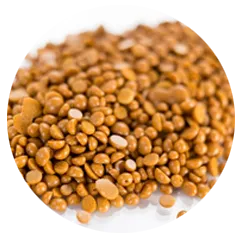-


-
RX 5217-M
——
Sugar cane is a monocotyledonous plant with a typical grass-like appearance. The origin is in East Asia but today sugar cane is being cultivated in every climatically region. The biggest countries are Brazil, India, China, Thailand, Pakistan and Mexico. Sugar cane wax is being extracted from the stalks of the sugar cane plant. To produce sugar, the sugary sap is being extracted from the plant. There is a by-product called bagasse. This filtration residue mainly consists of cellulose, hemicelluloses and lignin. After having cleaned the bagasse from plant residues and chlorophyll, it can be used for the production of sugar cane wax.
Sugar cane waxes are probably the most sustainable waxes. They contain 100 % sugar cane and are therefore pure natural products. Since the raw material is the filter residue of the sugar cane production, no further natural resources are being used. The added value of sugar cane plants is being increased significantly.-
0.000.00
-
——
Sugar cane is a monocotyledonous plant with a typical grass-like appearance. The origin is in East Asia but today sugar cane is being cultivated in every climatically region. The biggest countries are Brazil, India, China, Thailand, Pakistan and Mexico. Sugar cane wax is being extracted from the stalks of the sugar cane plant. To produce sugar, the sugary sap is being extracted from the plant. There is a by-product called bagasse. This filtration residue mainly consists of cellulose, hemicelluloses and lignin. After having cleaned the bagasse from plant residues and chlorophyll, it can be used for the production of sugar cane wax.
Sugar cane waxes are probably the most sustainable waxes. They contain 100 % sugar cane and are therefore pure natural products. Since the raw material is the filter residue of the sugar cane production, no further natural resources are being used. The added value of sugar cane plants is being increased significantly.
Technical Data
Items | Index | Method |
Appearance | Light amber Powder |
|
Particle size <17μm, % | ≤98 | ISO 13320 |
Drop point, ℃ | 72 - 82 | ASTM D3954 |
Penetration at 25℃, 10-1mm, | 3 - 10 | ASTM D1321 |
Density at 23℃, g/cm3 | 0.80 - 0.85 | ISO 1183 |
Application
Suitable for water-based and solvent-based systems
BIO plastics, BIO paints and coatings, BIO lubricants, BIO hot melts,
Paints and coatings
Excellent abrasion-,scratch-and mar-resistance in printing inks
Benefits
Natural wax from renewable raw materials with a very attractive price-performance ratio
Replacement of previously used fossi wax products in many applications
100% Bio-based wax
Compostable





